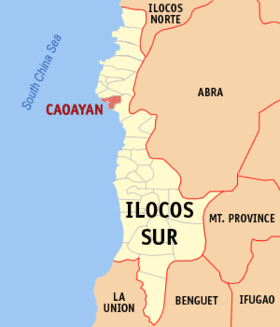Caoayan
Appearance
| Caoayan | |
|---|---|
| Baley na Filipinas | |
 | |
 Lokasyon na Caoayan | |
 | |
| 17°32′49″N 120°22′59″E | |
| Dalin | Filipinas |
| Barangay | 17 |
| Kaawang | |
| • Katiponan | 17.42 km2 (6.73 sq mi) |
| Elebasyon | 5 m (16 ft) |
| Bilang na too (Mayo 1, 2020)[1] | |
| • Katiponan | 19,574 |
| • Densidad | 1,100/km2 (2,900/sq mi) |
| Economia | |
| • Clase | kumapat ya klase ya baley |
| • Ingresos | ₱86,489,959.53 (2020) |
| • Activos | ₱447,411,189.70 (2020) |
| • Pasivos | ₱64,431,670.62 (2020) |
| • Gastos | ₱90,554,843.45 (2020) |
| Kodigo na postal | 2702 |
| Kodigo na lugar | 77 |
Say Caoayan et kumapat ya klase ya baley ed luyag na Ilocos ed Abalaten, Filipinas. Unong ed 1 Mayo 2020 census, say populasyon to et 19,574 totoo tan 4,838 abong. Walay kabaleg tan sukat to ya 17.42 sq. km. Say zip code to et 2702.
Saray barangay
[dumaen | dumaen so pinanlapuan]- Anonang Mayor
- Anonang Menor
- Baggoc
- Callaguip
- Caparacadan
- Fuerte
- Manangat
- Naguilian
- Nansuagao
- Pandan
- Pantay-Quitiquit
- Don Dimas Querubin (Pob.)
- Puro
- Tamurong
- Villamar
- Don Alejandro Quirolgico (Po
- Don Lorenzo Querubin (Pob.)
Demograpiko
[dumaen | dumaen so pinanlapuan]| Taon | Pop. | ±% p.a. |
|---|---|---|
| 1903 | 6,201 | — |
| 1918 | 7,860 | +1.59% |
| 1939 | 8,306 | +0.26% |
| 1948 | 9,064 | +0.98% |
| 1960 | 11,045 | +1.66% |
| 1970 | 12,670 | +1.38% |
| 1975 | 13,375 | +1.09% |
| 1980 | 14,070 | +1.02% |
| 1990 | 15,637 | +1.06% |
| 1995 | 15,799 | +0.19% |
| 2000 | 17,199 | +1.84% |
| 2007 | 18,914 | +1.32% |
| 2010 | 18,551 | −0.70% |
| 2015 | 19,861 | +1.31% |
| 2020 | 19,574 | −0.29% |
| Reperensiya: Philippine Statistics Authority[2][3][4] | ||
Saray reperensiya
[dumaen | dumaen so pinanlapuan]- ↑ "2020 Census of Population and Housing (2020 CPH) Population Counts Declared Official by the President". Hulyo 7, 2021. https://psa.gov.ph/content/2020-census-population-and-housing-2020-cph-population-counts-declared-official-president.
- ↑ Census of Population (2015). "Region I (Ilocos Region)". Total Population by Province, City, Municipality and Barangay. PSA. Retrieved 29 June 2016.
- ↑ Census of Population and Housing (2010). "Region I (Ilocos Region)". Total Population by Province, City, Municipality and Barangay. NSO. Retrieved 29 June 2016.
- ↑ Censuses of Population (1903–2007). "Region I (Ilocos Region)". Table 1. Population Enumerated in Various Censuses by Province/Highly Urbanized City: 1903 to 2007. NSO.
